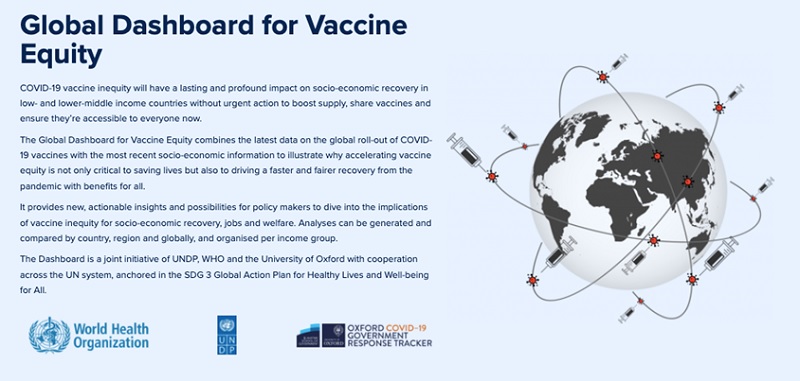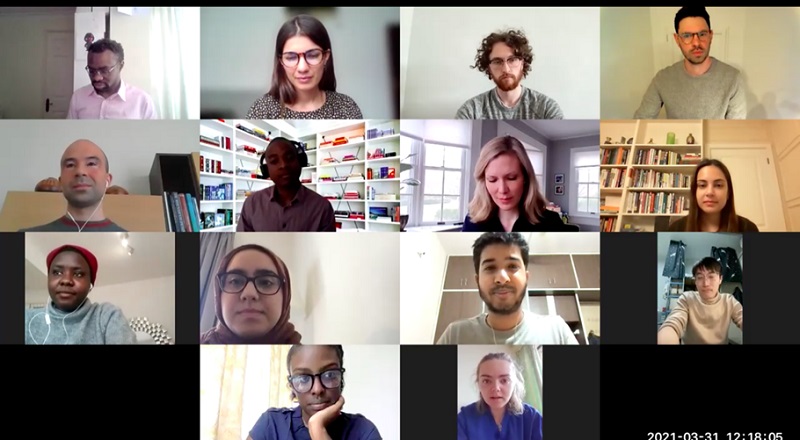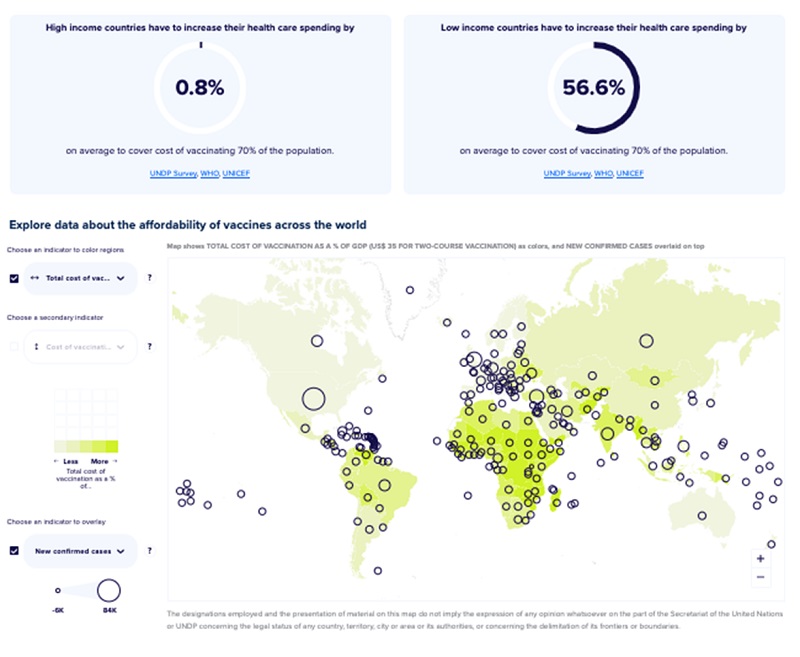Tackling vaccine inequity with multidimensional data
October 7, 2021
The COVID-19 vaccine coverage gulf between low-income and high-income countries continues to weigh down the global socio-economic recovery and reverse progress on the Sustainable Development Goals (SDGs) and the commitment to leave no-one behind. From July to September 2021, approximately 115 million people in high-income countries received a vaccine dose compared to only 10 million people in low-income countries.
As highlighted at the SDG Moment during the UN General Assembly this year, equitable access to vaccines is key to ending the COVID-19 pandemic, protecting vulnerable communities and people, and getting development back on track.
But how can we use data to capture the gaps in vaccine distribution and pricing and what exactly will it take to distill new insights on complex challenges in our uncertain world? This was the driving question behind the creation of the Data Futures Platform, which provides actionable insights to empower decision makers with comprehensive data to unlock a fair and fast recovery from the pandemic.
Let’s rewind. Our journey dates to December 2020, when amidst the COVID-19 crisis we convened around a so-called ‘data drawing board’ and explored ways to uncover the potential impact of COVID-19 through different recovery scenarios.
That’s how the Data Futures Platform came to be. UNDP’s one-stop-shop and open resource allows anyone to design development solutions and simulate policy choices and implications at global, regional, national and subnational levels. A powerful feature of the platform is the ability to visualize and overlay two to three indicators simultaneously, which allows for bespoke correlation analysis and inferences.
Today, almost a year later, you can find a range of resources to consider implications of alternative development pathways across sectors and systems. The Temporary Basic Income simulator, for example, shows the amount needed to lift the vulnerable out of poverty for 132 countries, based on three possible policy choices. Launched earlier this year, flagship research on COVID Impact on the SDGs highlights how integrated SDG investments can help low-income countries exceed the development trajectory we were on before the pandemic, even when considering the COVID impact. And the Global Recovery Observatory identifies green investment opportunities for governments and partners that are more impactful and sustainable.
These are just a few snapshots of our ongoing work. Stay tuned for upcoming additions, including a simulator showing how fossil fuel subsidies could be reallocated towards sustainable development priorities and mapping of global electricity access, which can support the effective targeting of electricity investment.
Collaboration and partnerships are at the heart of the new Vaccine Equity Dashboard. As we look to emerge and build forward better from the COVID-19 pandemic, you can use the Vaccine Equity Dashboard to zero in on actions that are needed and within reach today to help ensure access to affordable vaccines, as this will define how we recover from the COVID-19 pandemic.

The Dashboard is a joint initiative of UNDP, WHO and the University of Oxford with cooperation across the UN system, anchored in the SDG 3 Global Action Plan for Healthy Lives and Well-being for All
What started as a data mapping and collection exercise to fill in gaps on vaccine equity from a socio-economic impact perspective led us to mobilize cross-functional teams across UNDP working together with a group of interns from a variety of backgrounds, including law, medicine, health policy, finance, technology, political science, education, epidemiology, public health, and sociology, creating an interdisciplinary space.
Andrey Krachkov, one of our interns, shared his experience highlighting that, “Building the Dashboard with such a diverse team has been an incredible learning experience. The variety in expertise and mindsets has been key to exploring the array of social and economic costs that both high- and low-income countries would incur unless everyone has an equal shot of getting the shot.”

Multidisciplinary team of interns and UNDP colleagues
In developing the Dashboard, we collaborated with the World Health Organization and University of Oxford’s Blavatnik School of Government, which provided an opportunity for open dialogues, innovative thinking and connected us with a wider policy community. Together, our intention was to not just provide decision-makers with data on vaccine access and affordability, but rather share data stories that can act as advocacy tools and avenues for critical discussions.
Emily Cameron-Blake, Research Assistant with the Oxford COVID-19 Government Response Tracker, reflected on this ongoing partnership, emphasizing, “Our collaboration has also allowed us to more efficiently expand and disseminate crucial data on vaccine distribution and prioritisation by leveraging the people power of both teams.”
Dr. Thomas Hale, Associate Professor in Public Policy, at the University of Oxford’s Blavatnik School of Government added, “As the pandemic continues, getting vaccines to everyone in the world is the most important action we can take to lessen the damage to human life and to the economy. We at Oxford are therefore very proud to work with colleagues at UNDP to help understand what policies and practices shape vaccine delivery across countries. This information helps policymakers understand—and ultimately unblock--the different pinch points holding up vaccine rollout.”
Updated in real-time as new data becomes available and fully downloadable, the Dashboard combines the latest information on COVID-19 vaccination with the most recent socio-economic data to fill a critical gap and help guide the international community's understanding of what can be done to achieve vaccine equity.

Data on vaccine affordability across the world
The insights are striking. Projections show that richer countries could reach pre-COVID-19 per capita GDP growth rates by the end of 2021 while the economic impacts may last until 2024 in low-income countries. Our data also draws attention to how 2021 has seen a significant increase in the number of days of complete lockdown in countries with a large informal sector, including Uganda, the Democratic Republic of Congo, and Ghana, where national vaccination rates are too low to allow reopening of economies. In essence, low-income countries continue to depend on lockdowns as a policy response to curb the pandemic while vaccination rates remain low.
The Dashboard also underscores that speed is of essence in bridging the vaccine equity gap, if low-income countries had the same vaccination rates as high-income countries, their growth forecast would have been revised upwards by 1 percentage point, increasing their projected GDP by US$38 billion for 2021. But multidimensional data can help us build viable pathways and create credible policy options to not just achieve vaccine equity but also, in doing so, see progress across multiple SDGs over the next decade.
We believe that transformational shifts are enabled by evidence-based decision making and integrated analysis – and we are just getting started. As our team builds insights into the critical issues for COVID-19 recovery and SDG progress to help accelerate out of the pandemic with fairer, more sustainable development pathways, we invite you to join us by experimenting with our data and thinking through big challenges as part of this data driven collective for development impact.
-----
About UNDP SDG Integration:
UNDP’s Integration portfolio is focused on supporting stakeholders with approaches, methods, capabilities and spaces to go from knowing that complex development challenges require integrated approaches to ‘doing’ integration and leading systems change on a daily basis.
Find out more about integration in action by diving into the SDG Integration website: sdgintegration.undp.org/integrated-solutions and experimenting with data: data.undp.org.
Twitter: @SDGintegration
Email: sdgintegration@undp.org; data@undp.org

